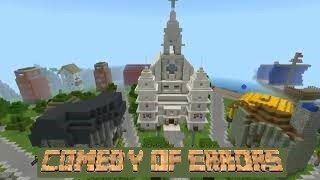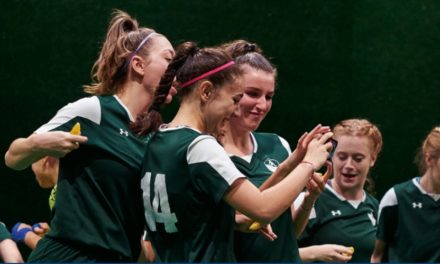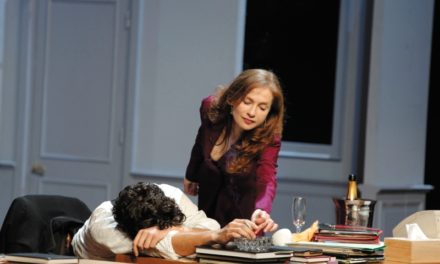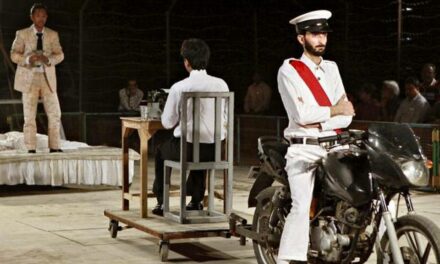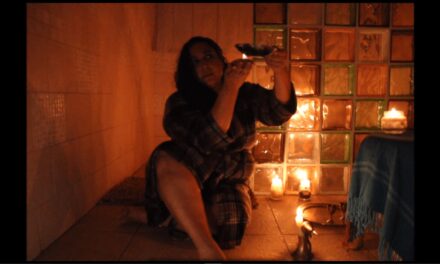Artist and Director, Susie Lawrence, takes on the challenging aspects of Covid-theatre to a new level with the creation of a Minecraft production of Comedy of Errors.
What do you do when you have a lot of 13-year-old drama students but no safe way to perform theatre at their school? You appeal to the audience. In this fascinating approach to virtual theatre, the Theatre Times takes a closer look at secondary students and their teacher and director, Susie Lawrence in their unique story of Comedy of Errors, Minecraft edition.
The production created for her middle school drama program became an accessible masterpiece in the fall of 2020 for online viewing with an interesting perspective to not only online performance but Shakespeare’s original work.
The play looks at the traditional work of Shakespeare’s Comedy of Errors but puts an important twist on it, modern-day video gaming. During a time when staying at home is mandatory in 2020, it is incredibly relevant and fascinating to see how such production was done. And it raises the questions; what is theatre now, how do we define it, and what are the limits in our current Covid world?
Q: Tell us about yourself. How did you get started in theatre? What schools did you attend and what previous positions have you had which put you in your current role? 
L: Theatre has always been a part of my life – as a child, I loved taking dance classes, acting in school plays, and “putting on a show” whenever I could find an audience! I was fortunate to be a part of a bustling drama program at Clayton High School and attended summer training programs such as Missouri Fine Arts Academy, The Heifer International Theatre Project, Shakespeare Festival St. Louis Acting Conservatory, and The Edinburgh Fringe Festival in Scotland. I earned my BFA in Acting at Millikin University, where I was a Presidential Scholar and studied abroad in London, England. After graduating in 2013, I worked with the renowned Shakespeare Theatre of New Jersey as an apprentice and performed professionally with the Shakespeare Festival of St. Louis, Ozark Actors Theatre, and Stray Dog Theatre. I also built my educational career as a teaching artist at SFSTL, The J, COCA, and STAGES St. Louis, where I was the Resident Teaching Artist for several years, directing productions at various schools.
Shakespeare has always been a passion of mine. I remember reading A Midsummer Night’s Dream in grade school and just falling in love with the magic, fairies, and poetic language. As I grew older, I sought out opportunities to hone my skills in Shakespearean performance and interpretation. My favorite Shakespeare productions are those that use the original language and story in a way that connects to contemporary life. When I introduce my students to Shakespeare, they always ask “Why are we studying plays written 400 years ago by a dead white guy?” It’s a valid question! The beauty in Shakespeare’s plays is that while they are old and sometimes problematic, they revolve around such common themes and human conflicts that we can almost always make them relatable.
Q: Tell me about the creative process of the Minecraft Comedy of Errors? What sparked the creation of this specific story?
L: When my colleague and I were building the season for Chaminade’s 20-21 Drama Department, I decided to produce The Comedy of Errors. It’s a play that I’ve worked on before (both as a director and actor), and I felt it would be a great piece to introduce young actors to Shakespeare and make relevant. My initial concept was to set the show in New Orleans during Mardi Gras, but when the COVID-19 pandemic necessitated shutdowns in March, I knew that I would have to dramatically reimagine the production. Around this time, I was also directing a production of Madagascar The Musical, that ended up being canceled when our school went remote. It was a painful experience that taught me a few lessons about best practices in theatre during COVID.
As I thought about the best way to produce theatre during this time, there were a few rules I had for myself: first, it had to be safe for students and artists. If Broadway was shut down, there was no way I was going to attempt an in-person performance. Second, the show had to be able to happen. I didn’t want to be put in the position again of having to cancel a production that my students and design artists had worked so hard on. And finally, it had to be fun and challenging. I knew that we could do a reading over Zoom – but I really wanted to recreate the action, movement, and artistry that comes with live theatre. I also wanted to be able to hire my design artists during a time when all performance projects had been shut down.
As I was spending a lot of time at home, the bulk of my socialization came from playing video games online with friends. I’ve been gaming for a few years now and being able to get “together” online with my community was a salve when I couldn’t see friends or family in person. During this time, I also came across a news article about a work group that had met up in a video game (Animal Crossing: New Horizons) for their meeting. They created avatar characters, met with one another in their virtual world, and communicated using Discord, which is a free application that you can communicate using voice, video, and text. That’s when I had a wild idea – why couldn’t I do the same thing with students, and put on our play within a video game? I immediately was excited by this idea – it would be safe, it could happen from the student’s homes, and it would be challenging. I could also create opportunities for my design artists to work instead of building a physical set, we could create an entire world online, accessible from anywhere! Not only that but putting a show online meant we could reach more people than ever, people who were stuck at home like me, wanting and needing stories and art, especially ones that lift our spirits.
When choosing the video game platform, I knew that I wanted to use a program that was easily accessible by students, had lots of resources for our scenic design team to build with, and something that was safe and family-friendly. My mind immediately went to Minecraft. I have been using Minecraft: Education Edition in my classroom for the past few years, having students create scenic designs for class projects, so I knew it was possible to create a pretty sophisticated design scheme. Minecraft has several playing options, and one of them allows players to create a “peaceful” world in “creative mode”, which you can keep private or allow hosting. This seemed like the perfect platform to build our world in.
After I nailed down this concept, I began to adapt the play. I didn’t add any text, but cut what I felt was outdated, problematic, or superfluous. I also added in a few “young” versions of characters to break up some lengthy speeches and allow more roles for students. As I worked on adapting the script, I was struck by the parallels between The Comedy of Errors and our new, COVID-19 world. The characters arrive in a strange land, one where they are not welcome. They have been separated from friends and family, and through many cases of mistaken identity, begin to question their own sanity. Every character has the idea of “reality” turned upside down, and during all this, the play moves quite fast – circumstances change at a lightning-fast pace! Is what the characters are experiencing real or imagined? Are they losing their grip on reality? These feelings of isolation, confusion, and frustration in a world that never seems to stop changing are ones that we all can relate to now more than ever.
Q: How did you work in rehearsal with the other students and crew?
L: All auditions, rehearsals, and callbacks were held remotely on Zoom. Before auditions, I held a Shakespeare Masterclass online for any student wanting to learn more about the play and how to interpret the Shakespearean text. This also gave them an opportunity to ask questions about the production.
Any student interested in joining the production, from acting to the scenic building in Minecraft, I met with one on one to audition and discuss the production with. After casting, we began with breaking down the text of the play – Shakespeare can be challenging, and I wanted my actors to understand every word they spoke and have strong delivery. These rehearsals were so enjoyable for me – we were able to focus deeply on the text of the play and weren’t rushed at all since there were no blocking to speak of just yet. We worked in this way for about 4 weeks. During this time, my scenic designer (George Shea) was working on renderings for the Minecraft world. He had a big job, as I was asking him not just to design a set, but a small city, complete with a town square, buildings, connecting roads, mountain ranges, a harbor, and several ships. These designs came out beautifully, and once we had some initial renderings, my student builders began working.
These students were supervised by my Technical Director Jim Robert, who greatly assisted in their building of the world and giving them clear objectives for each build day – just like he would if we were building a physical set. Each build day, I would meet with the actors on Zoom, and we would “open” the Minecraft world for the student builders to work. These student builders communicated with one another using a Discord server, so they could talk in real-time with one another as they worked. This also allowed us to keep an eye on the progress of the construction, since I knew we would need at least two weeks to get the actors acclimated to navigating the Minecraft world – some of them had never played the game before!
My goal was to have students designing and building the show to create an interactive world for the actors. The first day of having actors in the “world” online was pandemonium – they were so excited! It was a good challenge for them to voice act while controlling their avatar character, and in the end, I was very happy with how the production turned out. In this piece, I was trying to convey the themes of Comedy of Errors – that we are more alike than we are different, that we must take care of another, and that even in the craziest of circumstances, miracles can happen. For my cast and crew, I wanted to expose them to a new form of entertainment and communication – we even had our “cast party” online in Discord! That socialization and play were so important to them, and I was thrilled to see them bonding even though we weren’t physically together. For the audience, my goal was to present them with a theatrical experience they had never seen before and broaden their minds of what theatre can be.
Q: I saw the Comedy of Errors for Minecraft online, and I found myself feeling as though the piece had many parallels to traditional Shakespeare in this medium. Was this your aim?
L: I’m happy to hear that! I really hoped that the Minecraft world would recreate the feeling of entering a “world” in the theatre with sets, lights, and sounds. This play is mostly set outdoors, which also draws a parallel to shows produced at the open-air The Globe Theatre in London.
While I wouldn’t call this production “traditional” by any means, I do think that it lends itself to the most important part of any Shakespearean production – the text. The actors got to focus extensively on their delivery and interpretation in their voice acting, and this extra attention really shone through in their delivery. They knew the exact meaning of every word they spoke, and this confidence made the story clearer to the audience. No matter how brilliant a concept may seem, if the story is unclear, the concept falls flat. When directing, my mantra for my actors is “tell the story.” By being able to focus on their delivery and communication with one another, albeit remotely, they were able to hone in on the secret of performing good Shakespeare – understanding what you’re saying and why you’re saying it.
Q: I noticed as each character introduced themselves to the audience on their screens some students performed more traditionally when sharing their lines than others. What was the intention of the visual viewing of the actors alongside their virtual characters?
L: I wanted to create as dynamic a viewing experience as possible. Watching Zoom plays can get boring, just like watching cut scenes in a video game can. By including the avatars, Minecraft world, and video screens of the actors’ faces, my hope was to create an interesting visual for the audience. I also wanted the audience to be able to not only see the actor’s faces as they would onstage but to get a “behind the scenes” look at what goes into the art of voice acting.
In terms of the actor’s delivery, they each had their own style when voice acting. Actors were instructed to look directly into their webcam to create the illusion of “face to face” communication, but they also were tasked with moving their avatar character in the Minecraft world – and remembering all their lines! A few actors had incorporated lots of movement into their delivery, so staying “cheated out” just like they would onstage be an added challenge. I think they did a great job – we threw a lot at them, and they all handled it very professionally.
Q: What obstacles did you face when you were starting out creating this show?
L: There were many obstacles in creating this production. I had far fewer students audition than normal – some weren’t interested in the video game aspect, while others didn’t want to commit to any productions during such an uncertain time. None of us knew exactly what the fall and school would look like, so I understand the hesitation. In the end, having a small cast worked out extremely well when it came to programming and using the video conferencing software, so all’s well that ends well!
The tech week was the most challenging part of the production. My TD worked countless hours in programming using software called OBS, which lets you create “scenes” of different computer applications – similar to how we program light cues in a theatre. This OBS software gave us a lot of obstacles, mainly due to the fact that it can only handle up to nine webcams at a time, and we had a cast of thirteen. We spent several days troubleshooting, and actually found a workaround, but during that final tech rehearsal, we had our own “comedy of technical errors” – everything that could go wrong, went wrong. Cast member’s WIFI was dropping, the sound wasn’t going through, our YouTube live stream wasn’t syncing up properly, and the Minecraft server crashed repeatedly. It was a rough night, and I made the call to cancel the “live stream” aspect of the show.
My hope was to emulate normal theatre by having the live stream begin at 7 pm each evening, with ticket holders watching in real-time as the actors performed, so this was a tough choice to make. In the end, though, I knew it wasn’t fair to the cast and crew if our tech couldn’t meet the demands of my vision. I knew that each night would have major issues, and I knew that I had a duty to “tell the story” in the best way possible. So, on our “opening night,” we recorded the show. It took a while, but the cast was able to give their best performances without worrying about technical issues. My technical team (Jim Robert and Ethan Dudenhoeffer) spent all day editing the footage into the show you saw. In the end, I feel it all worked out for the best. The show lives on in its best form, the actors and their families can watch it any time they choose, and we are able to share it with others for as long as we want.
Q: If you could do it again, would you and what would you do differently? What if Covid was over would this format still be applicable or relevant for theatre?
L: Looking back, I would have made the decision to record the production from the start. This way, our tech week would have been less stressful for the cast and crew. We could have made stronger, more complex choices with the editing. And finally, we could have “live-streamed” the production each evening to recreate that live theatre experience. Producing live theatre is hard, and streaming true live theatre is even harder. Now that I have this experience, I know that the only way to live stream the show would be to have the cast together in person, and even then, having pre-recorded footage is always a good idea!
When COVID ends, this format will definitely still be relevant, but in a new way. Technology opens up a whole host of opportunities for onstage productions, and we should lean into that! This production also allowed us to build our “dream world” to perform in. In live theatre, we are limited to the set onstage, but by using technology, we can perform anywhere, and that’s a pretty exciting idea! We also can get more people involved in theatre than ever before. I had one actor who never did a show with us at Chaminade because she is homeschooled and lives quite far from campus – driving to rehearsals every afternoon is impossible for her family. Because we did the show online, she was able to be involved, make friends, and have a performance opportunity. Several of the crew members were new to the theatre scene as well – they got to show off their design skills in a brand new way, online!
We also can reach more audience members than ever before – one silver lining of the COVID-19 pandemic is the incredible assortment of productions you can stream at home. This trend should absolutely continue – why wouldn’t we want to share art with as many people as possible? Theatre should be accessible to everyone.
Q: What is theatre now, how do we define it, and what are the limits in our current Covid world?
L: To me, theatre has always been, at its core, storytelling. Onstage, we dramatize these stories and add technical elements to create a spectacle, but beyond the theatre, stories can take so many wonderful forms. Video games can tell stories just as effectively as cinema and stage, sometimes even more so! To me, the only limits in the COVID world are physical – to stay safe and healthy, we must physically distance ourselves from one another. For some, this means theatre is on hold so long as we can’t have the traditional theatre experience.
But stories have survived and thrived for thousands of years, so why can’t they thrive during this time as well? I think we need to let go of this notion that “theatre” only happens on stage in the traditional sense. That’s a stage performance, and it’s wonderful, but it isn’t the only form of “theatre.” I’ve always thought of theatre in an interdisciplinary way, so for me, going outside the typical norms of performance isn’t too far a stretch. Combining different mediums of art and performance helps us create the strongest pieces. Why shouldn’t we push the boundaries of what we consider theatre? Theatre for me is fluid, and I think to try to nail down a definition can sometimes limit us as performers and artists.
Q: How are you handling our current pandemic crisis regarding your work and what are your aspirations for the near future?
L: My next directing project is our Middle School show this spring when we will remount Madagascar The Musical. I’m playing with a lot of ideas right now – the show will most likely take place outdoors, and I would love to incorporate some live animals to tie into the “zoo” theme and setting. If the world is in a healthier state, this production would serve as a wonderful community event. Getting the Saint Louis Zoo involved would be a dream!
Beyond that production, I’ve also begun brainstorming for future seasons – I’m always thinking about what’s next! With COVID in mind, I want to experiment and incorporate more interdisciplinary art mediums into our theatre program. Instead of a traditional set with scene changes, I have this idea to incorporate graphic novel-style animations for next year’s play – I think that visual would be really powerful and could translate to a recording easily if needed. That plus some original music composed by students would be a really fun project! Last year, I had students compose a “soundtrack” for Holes by Louis Sachar, and it added a lot to the production. I would love to do a radio play on stage, like It’s a Wonderful Life, and adapt the concept to follow a more Brechtian style to highlight the relevant themes of unemployment, poverty, and mental health. Finally, I am excited to produce scripts that focus on social justice. Our young generations are more informed than ever before, and I want to showcase that energy and activism onstage.
These collaborative ideas excite me – what else can I add to the story? How can I get more students and professional designers involved? How can I “level up”, to use a video game reference? And finally, how can I make educational theatre relevant, cathartic, and exciting? It shouldn’t just be “the school play.” It should be a work of art. My aspirations for the future are broad – looking ahead, I would love to eventually get back into the professional theatre world of directing and producing, ideally with my own company. I’m excited to continue in my Masters’ program and look forward to completing it next year. For now, I plan to make the most of my current position. I want to experiment with new performance mediums, get more students and artists involved, and change lives by sharing and creating stories that matter.
You can watch the production on the school’s website here to view more or visit the YouTube page to stream for free.
This post was written by the author in their personal capacity.The opinions expressed in this article are the author’s own and do not reflect the view of The Theatre Times, their staff or collaborators.
This post was written by Melissa Denzer.
The views expressed here belong to the author and do not necessarily reflect our views and opinions.

